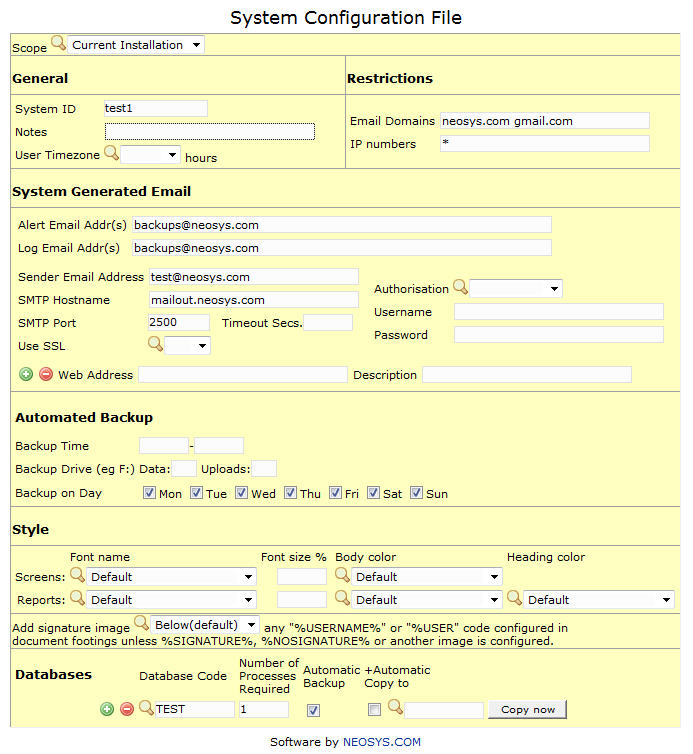System Configuration File: Difference between revisions
| Line 55: | Line 55: | ||
==System Generated Email== | ==System Generated Email== | ||
===Alert email | ===Alert email Addr(s)=== | ||
Enter the email IDs to which backup alert messages are sent. | Enter the email IDs to which backup alert messages are sent. | ||
===Log Email | ===Log Email Addr(s)=== | ||
Enter the email IDs to which the new log records are sent. | Enter the email IDs to which the new log records are sent. | ||
Revision as of 12:35, 18 September 2014
Scope
• All Installations
• Current Installation (default)
• Current Database
You can configure most items at the above “scopes”. Any item configured on higher/broader scope has priority over the same item on a lower/narrower scope. Assigning higher priority to higher/broader scopes allows us to override any and all individual installations/databases configurations with a particular configuration of our choosing. However it does not allow us to set a default configuration for all installations/databases and then separately configure each one where desired. That would require NEOSYS to assign priority to lower/narrower scopes – which it doesn’t do.
General
System ID
When upgrading older NEOSYS systems, System ID is automatically obtained from the username part of the smtp email sender.
For new installations, in NEOSYS Support Menu, enter the System ID in the System Configuration File.
System ID should be around 5 to 20 lowercase alphanumeric characters (only a-z and 0-9)
The ID should be sufficient to *very quickly* identify the client from all other NEOSYS clients. Abbreviations should not be invented or used unless INSTANTLY RECOGNISABLE. Understandable partial names may be better - eg promoaction instead of patdadddb. The fact that an accepted abbreviation exists does not count - it is acceptable only if the client is primarily known by the same abbreviation. Remember that the objective is to avoid the difficulty that the support staff face in figuring out what some abbreviations mean.
For example if the Client is called "TBI - The Big Idea" use the code bigidea and not TBI.
If this stage is omitted, the server name will be used which is often not ideal being something like neosys, server, neosys-server etc.
All processes will automatically restart within 10 seconds and then use the new configuration.
Notes
Any additional notes can be entered.
User Time zone
Configure time zone of the the client
Email Domains
Allows you to restrict the domain names that are acceptable when creating new users in the Authorisation File
IP numbers
Allows you to restrict access to specific IP numbers or IP ranges for ALL users.
Enter an asterisk to allow access for ALL users from any IP address. For example a client is hosted on NEOSYS server then a user of this client with a dynamic IP would require unrestricted access.
This configuration is overridden if IP restrictions are placed in the Authorisation File by user group. See Access Restriction by IP in Authorisation File
E.g. As shown below, enter the IP detail under Restrictions to restrict access and allow only from the IP range 195.229.241.* for all users
System Generated Email
Alert email Addr(s)
Enter the email IDs to which backup alert messages are sent.
Log Email Addr(s)
Enter the email IDs to which the new log records are sent.
Sender Email Address
Allows you to define what would be the sender’s email ID in automated mails sent from the system configuration file.
SMTP Hostname
Hostname of the email server e.g. mailout.neosys.com
SMTP PORT
Port No. on which the email server listens e.g. 2500
Username/Password
Required for mail servers that are not owned by NEOSYS. See [Using Client SMTP server]
Web Address and Description
Add Web Addresses which are given to users to access NEOSYS via the web. Links specified here will be part of the email sent to new users. Use the description field to describe the link e.g. users may be given two separate links, one for LAN access and one for WAN access. This information about the links can be specified in the description field.
Automated Backup
Backup Time: Define the time for backup to take place. If left blank, it assumes default backup time (1.00 AM).
Backup Drive (eg F: ) Used to define the drive to which the NEOSYS backup is done.
Uploads Used to define the drive to which the uploaded files should backup. Putting a 0 will disable backup of the uploaded files, else by default the uploaded files will be backed up to the drive mentioned in the backup drive field.
Backup on Day: The scheduled day for backup can be entered here. If all days are left unchecked, backup will be done on all days by default.
Style
Screens and Reports: Specifies whether the changes in Font Style apply to the text in screen or to the text in reports.
Font name, Font size%, Body color, Heading color: Allows you to choose a Font type, Font size and colour of the text.
Signature: Specifies where the signature image should be added in document footings.
Databases
Database code: Enter the databases code available in the installation to setup number of processes, automatic backup and copy for that particular database code
Number of Processes Required: Configure number of process required to automatically startup
Automatic Backup: Checkox to enable automatic backup which happens at backup time and backup drive specified above in the System Configuration file
+Automatic Copy to : Checkbox to enable copying of live database to test database nightly. Specify the TEST database code to which Live is copied
Copy now: Copy live database to test database on demand

